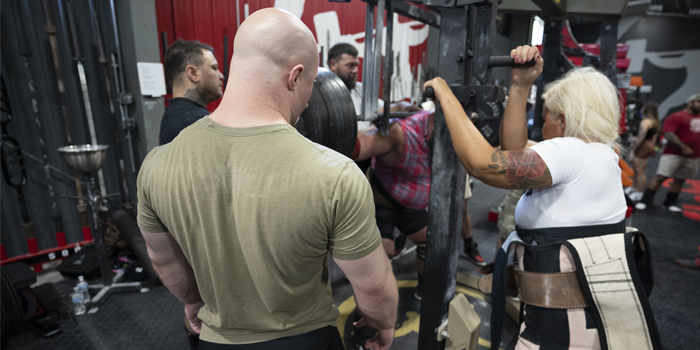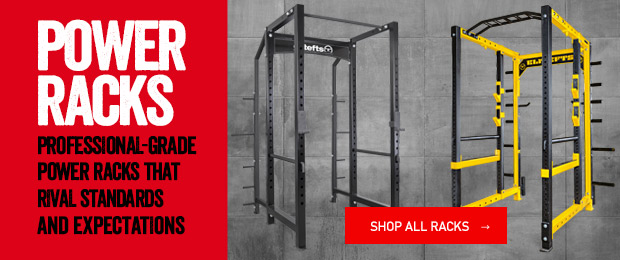
Before I delve into the topic, I think it would be remiss of me not to state my philosophies on training for strength which has developed over the last forty years and has been influenced by some of the great thinkers of our industry.
- Exercise selection is based on movement patterns, not just muscles.
- Training time should be 45 to 75 minutes in total.
- Strength underpins all other physical components in life.
- Any good program should include unilateral movements (single-limb) to identify and help correct weaknesses.
- Focus on the muscles you cannot see (e.g., pulling movements for both the upper and lower body).
- Understand CARE programming.
- Technique should always dictate the load used, not the opposite.
- Change the main movements and assistance exercises every three to four weeks to attain the best adaptions from the neural system. Use a variety of angles, bars, loading patterns, and equipment variations to sort out what best works for you.
- The ability to train is governed by the ability to recover, so less is often more.
- Different loading protocols (e.g., sets, reps, rest periods, %1RM) for various movements for different individuals for specific results. Any program should be adjusted for the individual, not the other way around.
- Individualize to prioritize to optimize.
Goals
I believe the first step in designing an effective weight training program is identifying for yourself the why of your training.
Do you want to increase muscle size? Do you want to get stronger?
Are you training to improve a specific sport?
Do you want to feel better and get about your daily activities with more vigor?
Once you have ascertained your why, the other factors in developing a good program will become clearer and easier to define.
Exercise Categories and Selection
How people categorize exercises has been a topic of conversation for many years. Still, the general consensus seems to be that exercises used in the gym fall into clearly defined areas. It would be far easier to decide on a classification of exercises if we had the luxury of the taxonomy of all living things first proposed by Swedish naturalist Carl Linnaeus. You might not remember the name, but he developed the often rote-learned taxonomic ranking system: Kingdom, Phylum, Class, Order, Family, Genus, and Species.
Exercise selection, although somewhat easier, is fraught with contradictions. Let us start with the most basic division of the upper body and lower body as the first level of organization. From this point, you can further break the exercises down into either pushing or pulling, with pushing tending to be anterior to the body and pulling posterior to the body. However, the biceps and triceps are the main exceptions in this discussion.
In recent times, the lower body has been divided not by pushing or pulling or anterior and posterior but by knee-dominant (squat) and hip-dominant (hinge) movements. Upper body movements tend to add another layer of nomenclature by declaring whether they are more vertical or horizontal. This can be confusing, as even though the bar movement in a bench press is moving vertically, the body itself is actually horizontal, so it is classified as an upper-body horizontal push. On the other hand, the shoulder press, where the bar is pressed vertically and the body is vertical, is classified as an upper-body vertical push movement.
I think Dan John does the best job in category organization, and I will use his taxonomy for the remainder of this article.
Push, Pull, Squat, Hinge, and Carry
In sports programming, I use quite a few additional exercise classifications, and with the proliferation of velocity-based training menus, you could also classify movements by speed. Gym Aware has compiled an excellent chart for just this purpose and a wonderful explanation by Bryan Mann on using this information for programming.
Some of the exercise categories I have used for sports programming are:
- Maximal strength (specifically Squat or Deadlift variations)
- Explosive (usually Olympic lifting derivatives but certainly has also included dynamic effort movements)
In one campaign for a touring team, I used the category of Starting Strength, Speed Strength, and Ballistic options as a catch-all for movements that I could use as a contrast to maximal effort movements. More on that later.
Exercise Selection Charts
When you have determined what categories you wish to program from, the next step is to list all the options for each category that you can program using the movements that you have available to you. This is one of the first jobs that I will do when I come into a new environment, irrespective of whether it is a sporting team or a commercial gym.
Performing an exercise inventory allows me to see exactly what I have available for my programming. It will also show me what I may need to budget for purchasing, and it may even help me rethink certain programming elements if I do not have the necessary tools.
You may never use the entire lists you develop, but it will ensure you have options available as you educate your people in training. Education is one of the most overlooked elements of most gym programs for the members, but organizing an exercise selection chart is a step in the right direction. This link to my Dropbox will provide you with examples of charts I have developed and used with various teams and gyms over the years.
Time
Your time availability will determine the number of exercises you can do in a training session. There are many different types of sessions you can choose from. All sessions will have a CARE (Core Accessory Rehab Exercise) element attached to the main movements to ensure that all areas of the body are trained.
The other aspect of time that you need to consider is the rest period between sets to optimize recovery and allow you to give your best effort on each set. If you are training for strength—usually in the 2-6 reps per set zone—I recommend you rest at least 3 minutes between sets. If you are training more for size—usually in the 8-12 reps per set zone—I suggest you rest less than a minute between sets. If you are supersetting, you have minimal time between exercises and take 60-90 seconds rest at the end of the superset.
Full Body Exercise Prescription
| Number of Exercises | Type of Program | Examples of Exercise Selection |
| 2 | Pull and Push | Deadlift, Bench Press |
| 2 | Squat and Push | Box Squat, Shoulder Press |
| 3 | Push and Pull Loaded Carry | Deadlift, Bench Press, Farmer's Walk |
| 3 | Squat, Push, and Loaded Carry | Box Squat, Shoulder Press, Sandbag Bear Hug Walk |
| 3 | Push, Pull, and Squat | Shoulder Press, Deadlift, Sprinter's Squat |
| 4 | Push, Pull, Squat, and Loaded Carry | Shoulder Press, Deadlift, Sprinter's Squat, Waiter's Walk |
| 4 | Hinge-Dominant, Knee-Dominant, Upper Body Push, and Upper Body Pull | Deadlift, Safety Bar Box Squat, Bench Press, Prone Row |
| 5 | Hinge-Dominant, Knee Dominant, Upper Body Push, Upper Body Pull, and Loaded Carry | Good Morning, Step Ups, DB Shoulder Press, One-Arm DB Row, Suitcase Carry |
I prefer a full-body training program so that you can train all movements three times a week. It caters to people who cannot commit to more training sessions per week. Also, if you feel you need to split your workout, there are a plethora of options available to you.
Resource: To Split or Not to Split: The Athlete-Training Question
Irrespective of which program you choose to follow, the CARE program will assist your overall development. It will also minimize the risk of injury and improve all your numbers because stabilizer muscle groups are trained.
I suggest you select 3-5 categories below and perform 2 sets of 10 reps. Try to include various movements to ensure balance in your program. The tables below have a specific exercise as an example, choose exercises that work for you and ensure that you train that category twice a week for full effect.
CARE Program (Core Accessory Rehab Exercise Program)
Sets, reps, and load will be needs-based.
| Groin | Knee | Ankle | Rotator Cuff | Shoulder Joint Integrity | Scapula Posterior Shoulder | Elbow Joint Integrity |
| Copenhagen Plank | Single-Leg Squat to Bench | Single-Leg Calf Raises | Cuban Press | 3-Way Shoulder Raise | Face Pulls | DB Hammer Curl Superset LyingTriceps Ext. |
| Grip | Hamstrings | Neck | Core Anti-Rotation | Core Loaded | Core Unloaded | Thoracic Mobility |
| Farmer's Walk | Nordic Curls | Banded Look Aways | Pallof Press | KB Waiter's Walk | Rollouts | Overhead Squat |
Sets and Reps
Sets, reps, and load plans will depend on your current training goal. To simplify the equation, I have outlined a basic plan for a four-week training period, depending on whether you are training for size or strength and when you are training single limbs (unilateral) or both limbs (bilateral).
There are many protocols used in sports training, but I have simply listed ideas for most people to use in commercial training facilities utilizing the Dan John Exercise taxonomy.
| Week | Size and Unilateral | Strength and Bilateral |
Week 1 Week 2 Week 3 Week 4 | 4 x 12 @ 65% 4 x 8 @ 75% 5 x 10 @ 70% 5 x 6 @ 80% | 4 x 6 @ 75% 4 x 4 @ 90% 5 x 5 @ 85% 3 x 3 @ 90+% |
Conclusion
I think that programming is a blend of art and science, but at its heart, it's about helping people get better every day by listening to what they want while including what they need. Also, it will educate them on why you are using these sets and reps and which exercises are needed to suit them best. Not all programs are the same, just like no two people are the same.
I hope this article assists you in making informed decisions for your training and the training of others that place their bodies in your care.

Ashley Jones has worked in three professional sports across 30 years and four continents. He was awarded the NSCA's Professional Coach of the Year in 2016. Ashley holds his CSCS (Certified Strength and Conditioning Specialist) since 1988 and is an honorary lecturer in the School of Therapeutic Sciences, University of Witwatersrand, Johannesburg, SA.










https://www.dropbox.com/sh/edvdg27i08npgdq/AABZ7dr9KPpblD76oc5hkSC1a?dl=0
Thanks an appreciate the information you have been putting out over the years!